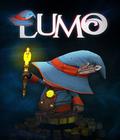Gaming in the '80s was a very different experience for UK players compared to their counterparts in Japan and North America. For example, they never experienced the video game crash. While the NES was so wildly successful that it was considered the de facto way to game, those across the pond were perfectly content with the Commodore 64, Amstrad CPC, and the well-known ZX Spectrum. Also, the UK was the one place where the isometric perspective really took off. Lumo pays its respects to the UK retro game scene by taking those sensibilities and giving them a more modern presentation. The result is a game that is universally enjoyable.
The quaint story is very familiar if you remember the '80s well enough. Playing as either a nondescript boy or girl, you arrive at a park in time to attend a small classic gaming expo. Amidst the old posters, arcade machine, and consoles, you find a very old computer tucked away in the back corner of the room. After fiddling with it for a while, you're shot by a ray gun and transported into the game as a wizard. Without any real guidance, you wander the world to discover that you must find a few key items if you are to return to your own world.
With the exception of a few tweaks to the narrative, those opening moments should remind you of the old sci-fi film "Tron," and it doesn't take long before the game pays homage to something else from that era. "Ghostbusters" and "Raiders of the Lost Ark" are just some of the movie references, and video game classics like Bubble Bobble, Pac-Man,and Zaxxon also get nods here and there. There's also a wide smattering of references specifically to stuff that would be more familiar with the British. While there are a few modern references that may feel out of place when compared to everything else, they make sense when you realize that those items are also of British origin. With so many other games gunning for the North American and Japanese retro experiences, it's refreshing to see a title aim for something different.
At its core, Lumo is an isometric puzzle platformer in the classic sense. The adventure is spread over 500 rooms, and the objective is usually to go from one entrance to another while avoiding everything in your way. The game has no combat, but it's laden with flames, pits, spikes, and other traps that kill in one hit. Most puzzles are of the switch variety, but things are usually interconnected, so hitting a switch in one room may affect something somewhere else. Some key items are scattered all over the stages, and while this does mean backtracking, it's pretty limited since solving the mystery of one floor generally means you won't have to revisit it again.
The puzzles have a natural progression in difficulty. Things start off with simple jumping puzzles on floating platforms that eventually turn into crumbling ones and weight-sensitive ones, all of which respawn after a few seconds. Spikes and poison water follow soon after, along with flames coming out of floors and rotating boxes. Things escalate rather quickly, as you may swim underwater while watching your oxygen levels, float across a danger-laden path in a fragile bubble, and roll across a precarious path using a ball and reversed controls. That's all without mentioning the required ice area, which introduces the expected character control issues.
If that weren't enough, things start to turn strange. You'll briefly move away from the dungeon setting into a more nebulous area, where paths only form when you walk and floating platforms spiral out of control. You'll get on mine carts that glide along pieces of broken track or slide down a slope, complete with slalom gates to pass through. There are even replicas of older games that you have to go through. Much like the earlier references, they initially seem out of place until you realize that you're stuck in a computer, so having multiple games thrown in for the hell of it makes more sense.
All of the references and oddities wouldn't mean much if the difficulty rendered things nearly impossible. Fortunately, the difficulty scales nicely, and while there are a few puzzles that require you to take your time and think, nothing is obtuse enough to require frequent FAQ consultation. The game is also quite forgiving when it comes to progression. You can save anywhere you want to, you have infinite lives, and you quickly respawn at the last doorway you entered. As a result, the game doesn't become frustrating since it always encourages you to give it another go, even if you've failed the same room for the umpteenth time.
The game isn't very long, so you can finish it in an afternoon if you're dedicated, but there are plenty of reasons to revisit the campaign. Lumo has plenty of collectibles, from maps to cassette tapes to coins and rubber ducks. Some of these are easily encountered along the main path while others are tucked away in secret rooms that require a bit of snooping to uncover. The ducks are particularly vexing, since they are often in plain sight but require great dexterity — and the knowledge that you can bounce off them — to obtain. Warp zones to game homages are scattered throughout and are much harder to uncover than everything else. Though none of those items give you anything extra within the context of the game, their related Trophies are so rare that obtaining them all is well worth the satisfaction. If you really want a challenge, the game also offers up the Old School difficulty, which disables the ability to save in exchange for three extra lives. You are expected to beat the game in one go with this difficulty on, a Herculean task for some and a reminder for others that current players have it so much easier.
With so much that Lumo does right, it only has a few faults. Even though you can shift the camera around, the isometric viewpoint remains fixed at all times, so there's only one angle you can see. This is reminiscent of the classic games at the time, but because it is a viewpoint that is rarely used in the platforming realm, it can be very difficult for players to make otherwise simple jumps. The hitbox for spikes also doesn't help, as they seem larger than normal, and for a game that requires some pixel-perfect leaps, this means you'll be encountering quite a few deaths that aren't your fault. Even though it is meant to emulate the mechanics of older games, it would've been nice to see the maps updated with things, like a clearer indication of which floor you're looking at or your location in relation to the map.
The title doesn't go for the complete retro look, but it also doesn't aim to be a showcase title for the system. For the most part, you're traversing a dungeon, and while the textures look absolutely clean, there's not much to really get excited about. The lack of creatures means you're the only character in the game, and you move well enough despite being rather short and stocky. The rooms take advantage of the hardware by being rather sizeable, and there's plenty of light and shadows. There's also slightly too much lens flare when something bright happens on-screen. Despite this, the game still looks rather striking since you're essentially in a series of rooms floating around a static space background. It looks rather strange at first, but you'll soon appreciate the eerie atmosphere. While nothing spectacular comes from this, it's a better option than a pure black backdrop.
Like the graphics, the sound goes for classic fundamentals instead of more modern ones. There are little bits of chiptune in the soundtrack, the score is mostly standard adventure fare with bits of silence thrown in to alleviate fatigue. The only time the soundtrack is absurd is when you get the beauty shot of a key item you just obtained. The effects are fine but nothing special, since you'll pay more attention to the score instead, but the small sampling of old-school game effects here are nice little surprises. The game is devoid of voices, with the exception of the high-pitched squeal of your character dying; it's a sound you'll have to get used to since you'll hear it over and over again throughout your journey.
Lumo is an enjoyable puzzle platformer. Putting aside the isometric perspective, the challenges feel right, and it's satisfying to solve each one of them. It is enough to offset the humor if you don't get the references, and the challenge lasts long enough without feeling tiresome. Even though the UK players will get the most out of the title since it's tailored to their retro scene, it is still fun for everyone and well worth owning if you're a fan of something different in puzzle platforming.
Score: 8.0/10
More articles about Lumo










 Lumo is a modern take on the classic isometric-styled action platformers that were highly popular in the '80s and early '90s.
Lumo is a modern take on the classic isometric-styled action platformers that were highly popular in the '80s and early '90s.










